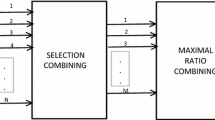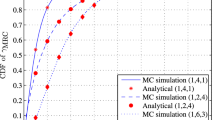Abstract
This paper studies the problem of optimal power allocation (OPA) over independent but not necessarily identically distributed time-varying Rayleigh fading channels with maximum-ratio combining to exploit transmit and/or receive diversity. Specifically, the optimal average rate-maximizing and M-ary phase shift keying symbol-error-rate (SER)-minimizing power allocation problems subject to a total transmit power constraint are formulated as stochastic optimization problems. After that, the stochastic problems are reformulated into deterministic ones in terms of the average rate and SER, respectively, which require only partial channel state information (CSI) in the form of channel gains. Novel closed-form expressions are derived for the deterministic OPA for average rate-maximization and SER-minimization, and a linear-complexity water-filling algorithm is then proposed to efficiently determine the OPA based on derived closed-form solutions. Moreover, dynamic OPA (with full CSI knowledge) is analyzed and closed-form solutions for the optimal average rate and SER are obtained. Simulation results are presented to validate the theoretical analysis, and demonstrate that the deterministic OPA algorithm outperforms equal power allocation and yields comparable average rate and SER performances to the dynamic OPA.



Similar content being viewed by others
References
Liu, K. J. R., Sadek, A. K., Su, W., & Kwasinski, A. (2008). Cooperative communications and networking. Cambridge: Cambridge University Press.
Piazza, D., & Milstein, L. B. (2007). Analysis of multiuser diversity in time-varying channels. IEEE Transactions on Wireless Communications, 6(12), 4412–4419.
Luo, J., Blum, R. S., Cimini, L., Greenstein, L., & Haimovich, A. (2005). Power allocation in a transmit diversity system with mean channel gain information. IEEE Communications Letters, 9(7), 616–618.
Cao, L., Tao, M., & Kam, P. Y. (2009). Power control for MIMO diversity systems with nonidentical Rayleigh fading. IEEE Transactions on Vehicular Technology, 58(2), 998–1003.
Feng, W., Chen, Y., Ge, N., & Lu, J. (2015). Optimal energy-efficient power allocation for distributed antenna systems with imperfect CSI. IEEE Transactioncs on Vehicular Technology, 65(9), 7759–7763.
Dang, X., Wang, Y., & Yu, X. (2016). Suboptimal energy efficient power allocation scheme for distributed antenna system with antenna selection. IET Electronics Letters, 52(4), 264–266.
Havary-Nassab, V., Shahbazpanahi, S., Grami, A., & Luo, Z.-Q. (2008). Distributed beamforming for relay networks based on second-order statistics of the channel state information. IEEE Transactions on Signal Processing, 56(9), 4306–4316.
Annavajjala, R., Cosman, P. C., & Milstein, L. B. (2007). Statistical channel knowledge-based optimum power allocation for relaying protocols in the high SNR regime. IEEE Journal on Selected Areas in Communications, 25(2), 292–305.
Baidas, M. W., Alsusa, E., & Hamdi, K. A. (2016). Power allocation over time-varying multi-user multi-relay amplify-and-forward networks. IET Communications, 10(18), 2636–2648.
Baidas, M. W., Alsusa, E., & Hamdi, K. A. (2016). Network sum-rate maximizing and max-min rate power allocation over time-varying multi-user multi-relay amplify-and-forward networks. In Proceedings of IEEE wireless communications and mobile computing (IWCMC) conference, Paphos, Cyprus, September 2016 (pp. 600–605).
Baidas, M. W., Alsusa, E., & Hamdi, K. A. (2016). Power allocation over time-varying multiple-access interference channels. International Journal of Communication Systems, 29(13), 2041–2058.
Baidas, M. W., Alsusa, E., & Hamdi, K. A. (2016). Network sum-rate maximizing power allocation over time-varying multiple-access interference channels. In Proceedings of IEEE wireless communications and networking conference (WCNC), Doha, Qatar.
Chen, Z., Yuan, J., & Vucetic, B. (2005). Analysis of transmit antenna selection/maximal-ratio combining in Rayleigh fading channels. IEEE Transactions on Vehicular Technology, 54(4), 1312–1321.
Winters, J. H. (1998). The diversity gain of transmit divesity in wireless systems with Rayleigh fading. IEEE Transactions on Vehicular Technology, 47(1), 119–123.
Hamdi, K. A. (2008). Capacity of MRC on correlated Rician fading channels. IEEE Transactions on Communications, 56(5), 708–711.
Hamdi, K. A. (2010). A useful lemma for capacity analysis of fading interference channels. IEEE Transactions on Communications, 58(2), 411–416.
Abramowitz, M., & Stegun, I. A. (1970). Handbook of mathematical functions, with formulas, graphs and mathematical tables (9th ed.). New York: Dover Publications.
Boyd, S., & Vandenberghe, L. (2004). Convex optimization. Cambridge: Cambridge University Press.
Jost, J., & Li-Jost, X. (2008). Calculus of variations. Cambridge: Cambridge University Press.
Tse, D., & Viswanath, P. (2005). Fundamentals of wireless communications. Cambridge: Cambridge University Press.
Simon, M. K., & Alouini, M. S. (1998). A unified approach to the performance analysis of digital communications over generalized fading channels. Proceedings of IEEE, 86(9), 1860–1877.
Caire, G., Taricco, G., & Biglieri, E. (1999). Optimum power control over fading channels. IEEE Transactions on Information Theory, 45(5), 1468–1489.
Gradshteyn, I. S., & Ryshik, I. M. (2007). Table of integrals, series and products (7th ed.). New York: Academic Press.
Ross, S. M. (2010). Introduction to probability models (10th ed.). New York: Academic Press.
Author information
Authors and Affiliations
Corresponding author
Additional information
Publisher’s Note
Springer Nature remains neutral with regard to jurisdictional claims in published maps and institutional affiliations.
Rights and permissions
About this article
Cite this article
Baidas, M.W., Hamdi, K.A. & Alsusa, E.A. On Optimal Power Allocation over Time-Varying Rayleigh Fading Channels for Maximum-Ratio Combining in Diversity Systems with Partial CSI. Wireless Pers Commun 104, 1243–1260 (2019). https://doi.org/10.1007/s11277-018-6078-6
Published:
Issue Date:
DOI: https://doi.org/10.1007/s11277-018-6078-6




